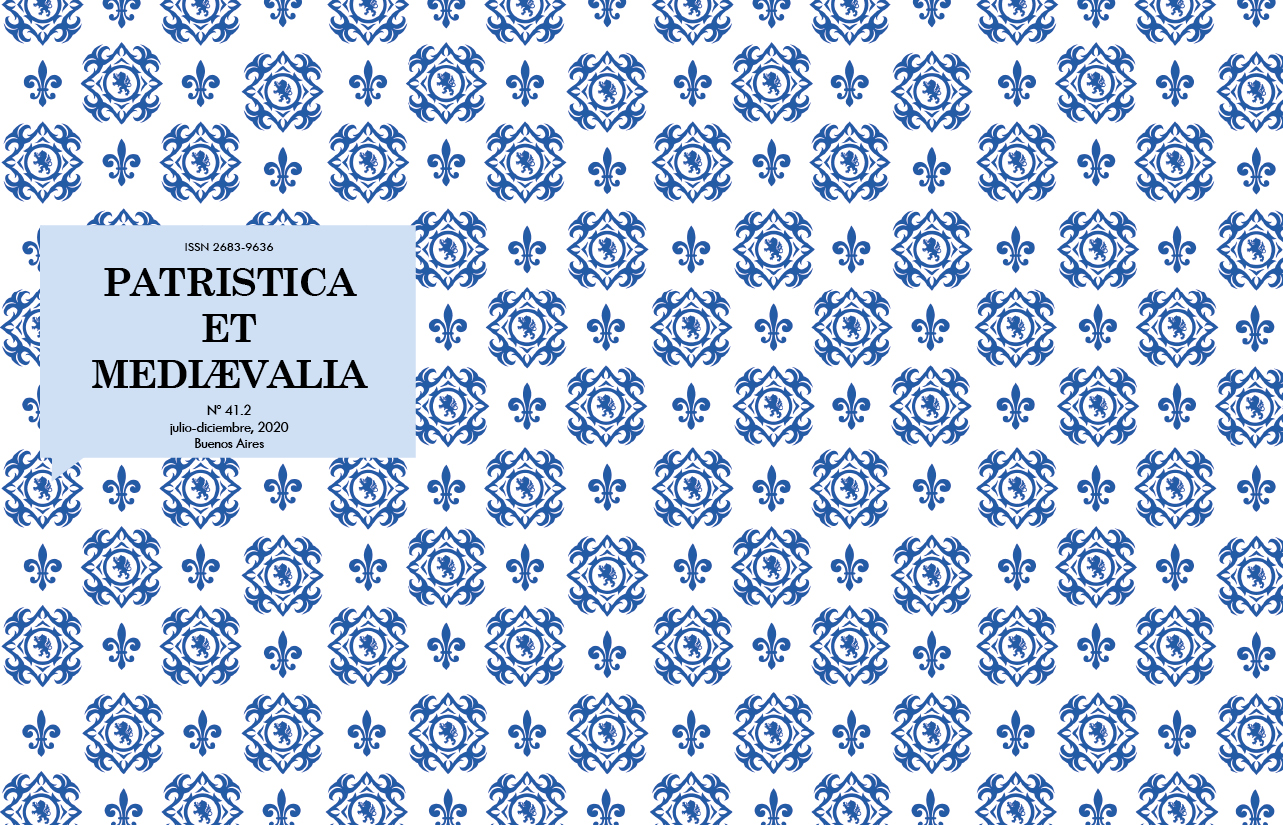The Definition of “man” and the Structure of the Liber differentiarum II of Isidore of Seville
Abstract
This article deals with the structure of the Isidorian treatise called Liber differentiarum II (Diff. II). Up to now, researches about the content of the work and its distribution have explained its structure according to considerations that it could be called “external”, as they are based on general ideas around text genre or logic. However, I aim to offer an “internal” explanation of such a structure based on its conceptual content. The hypothesis holds, then, that the basis for articulating the entire work is the definition of “man” that Isidore develops in Diff. II.13, as well as its place on the chain of beings (Diff. II.16). Indeed, the special position of the human being, who is considered both by Isidore and by his sources as a universal creature intermediate between God (pure intellectual spirit) and material beings lacking reason, is of capital importance for understand and structure the work.Downloads
References
Andrés Sanz, M. A. (2000). “Relación y transmisión manuscrita de los tres libros de Differentiae editados en P.L. 83 (Isidoro de Sevilla)”, Revue d’Histoire des Textes 30, 239-262.
Andrés Sanz, M. A. (2006a). “Introducción general. Bibliografía. Apéndice” y “Conspectus siglorum”. En: Isidorus Hispalensis. Liber Differentiarum [II]. Ed. Idem. Turnhout: Brepols. (CCSL 111A), 7*-323* y 3-5.
Andrés Sanz, M. A. (2006b). “Una reelaboración de textos isidorianos en forma de ‘interrogationes et responsiones’”, Helmantica 72, 29-48.
Bejczy, I. (2011). The Cardinal Virtues in the Middle Ages. A Study in Moral Thought from the Fourth to the Fourteenth Century. Leiden-Boston: Brill. (Brill’s Studies in Intellectual History 202).
Brugnoli, G. (1964). “Il Liber de differentiis rerum di Isidoro di Siviglia”, Vetera Christianorum 1, 65-82.
Codoñer, C. (1963). El De uiris illustribus de Isidoro de Sevilla. Salamanca: CSIC- Instituto «Antonio de Nebrija».
Codoñer, C. (1985). “Les plus anciennes compilations de Differentiae: formation et évolution d’un genre littéraire gramatical”, Revue de Philologie, de Littérature et d’Histoire Anciennes 59, 201-219.
Codoñer, C. (1986). “La conception de la Differentia dans le recueil Inter Aptvm d’Isidore de Séville”, Revue de Philologie, de Littérature et d’Histoire Anciennes 60, 187-196.
Codoñer, C. (1992a). “Differentia y etymologia, dos modos de aproximación a la realidad”. En: Holtz, L. y Fredouille, J.-C. (eds.). De Tertullien aux mozarabes. Mélanges offerts à Jacques Fontaine à l’occasion de son 70e anniversaire (vol.1). París: Institut d’études augustiniennes; Turnhout: Brepols. (EAA 132), 19-30.
Codoñer, C. (1992b). “Introducción”. En: Isidoro de Sevilla. Diferencias. Libro I. Ed. Idem. París: Les Belles Lettres, 77-82.
Codoñer, C. (1994). “Fases en la edición de las Etymologiae, con especial referen- cia al libro X”, Evphrosyne: Revista de filología clásica 22, 125-146.
Codoñer,C.(2011). “La enciclopedia. Un género sin definición. SiglosI a.C.- VII d.C.”. En: Fossati, C. (ed.). Giornate filologiche genovesi: l’enciclopedismo dall’Antichità al Rinascimento. Génova: Dipartimento di Antichità, Filosofia e Storia, 115-154.
Concilio-Arzobispado de Toledo (ed.) (1989). Concilio III de Toledo: XIV Centenario, 589-1989. Toledo: Caja Toledo.
Fontaine, J. (1983). Isidore de Séville et la culture classique dans l’Espagne wisigothique. París: Institut d’Etudes Augustiniennes; Turnhout: Brepols. (EAA 100-101).
Fontaine, J. (2000). Isidore de Séville. Genese et originalité de la culture hispanique au temps des Wisigoths.Turnhout: Brepols. (TH 8).
Formigari, L. (1973). “Chain of Being”. En: Wiener, P. P. (ed.). Dictionary of the History of Ideas. Studies of Selected Pivotal Ideas (vol. 1). Nueva York: Charles Scribner’s Sons, 325-335.
Gasti,F.(1998). L’Antropoligia di Isidoro. Le fonti de llibro XI delle Etimologie. Como: Edizioni New Press.
Kuntz, P. G. (1987). “‘From the Angel to the Worm’. Augustine’s Hierarchical Vision”. En: Kuntz, M. L. e Idem (eds.). Jacob’s Ladder and the Tree of Life. Concepts of Hierarchy and the Great Chain of Being. Nueva York - Bern - Frankfurt am Main: Peter Lang, 41-53.
Lovejoy, A. O. (1933). The Great Chain of Being. A Study of the History of an Idea. Cambridge, Mass.: Harvard University Press.
Magallón García, A.-I. (1996). La tradición gramatical de differentia y etymologia hasta Isidoro de Sevilla. Zaragoza: Departamento de ciencias de la Antigüedad - UniZar.
Newhauser, R. (ed.) (2005). In the garden of evil. The vices and culture in the Middle Ages. Toronto: Pontifical Institute of Mediaeval Studies.
Nisula, T. (2012). Augustine and the Functions of Concupiscence. Leiden - Boston: Brill.
O’Meara, D. J. (1987). “The Chain of Being in the Light of Recent Work on Neoplatonic Hierarchies”. En: Kuntz, M. L. y Kuntz, P. G. (eds.). Jacob’s Ladder and the Tree of Life. Concepts of Hierarchy and the Great Chain of Being. Nueva York - Bern - Frankfurt am Main: Peter Lang, 15-30.
SánchezMartínez,C. (2000). La etimología latina. Concepto y métodos. Murcia: Servicio de Publicaciones de la Universidad de Murcia.
Zöckler, O. (1893). Das Lehrstück von den sieben Hauptsünden: Beiträge zur Dogmen- und zur Sittengeschichte, in besonders der vorreformatorischen Zeit. Múnich: Becker.
1. The authors who publish in this magazine accept the following conditions:
-
They retain the copyright and grant to the magazine the right of the first publication, with the work registered under the Attribution-ShareAlike 4.0 International License that allows third parties to use what is published as long as they mention the authorship of the work and the first publication in this magazine.
-
They can make other independent and additional contractual agreements for the non-exclusive distribution of the version of the article published in this magazine (eg. include it in an institutional repository or publish it in a book) provided that they clearly indicate that the work was first published in this journal.
-
They are allowed and recommended to publish their work on the Internet (for example on institutional or personal pages).
2. AutoArchive Conditions. Authors are allowed and encouraged to distribute post-print electronic versions of their manuscripts because it promotes their circulation, a possible increase of quotation and a major reach among the Academic community. Color RoMEO: blue.













